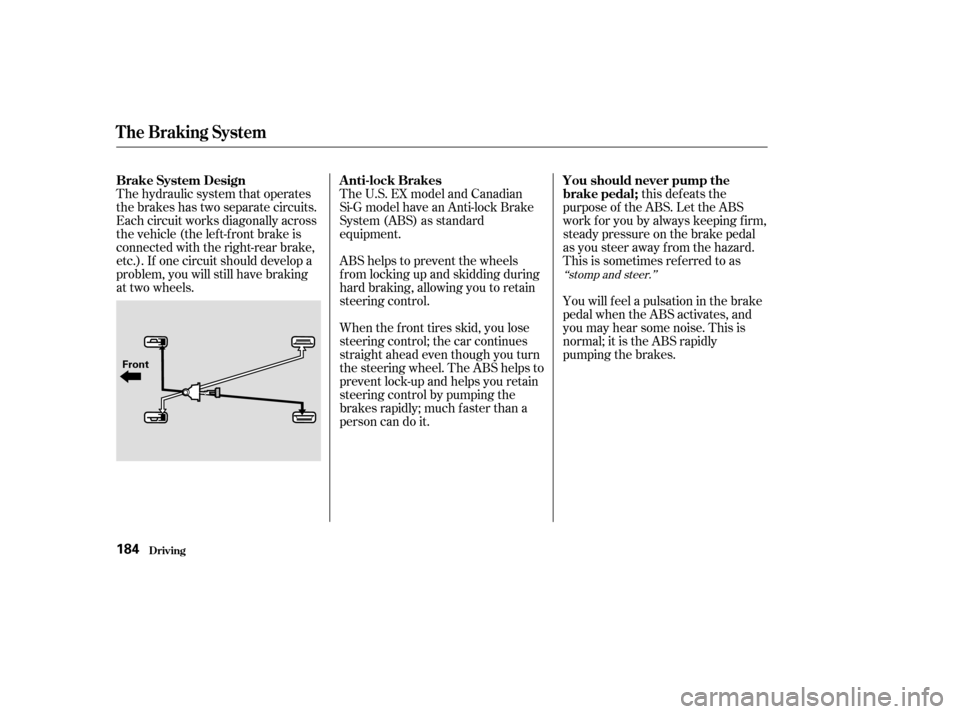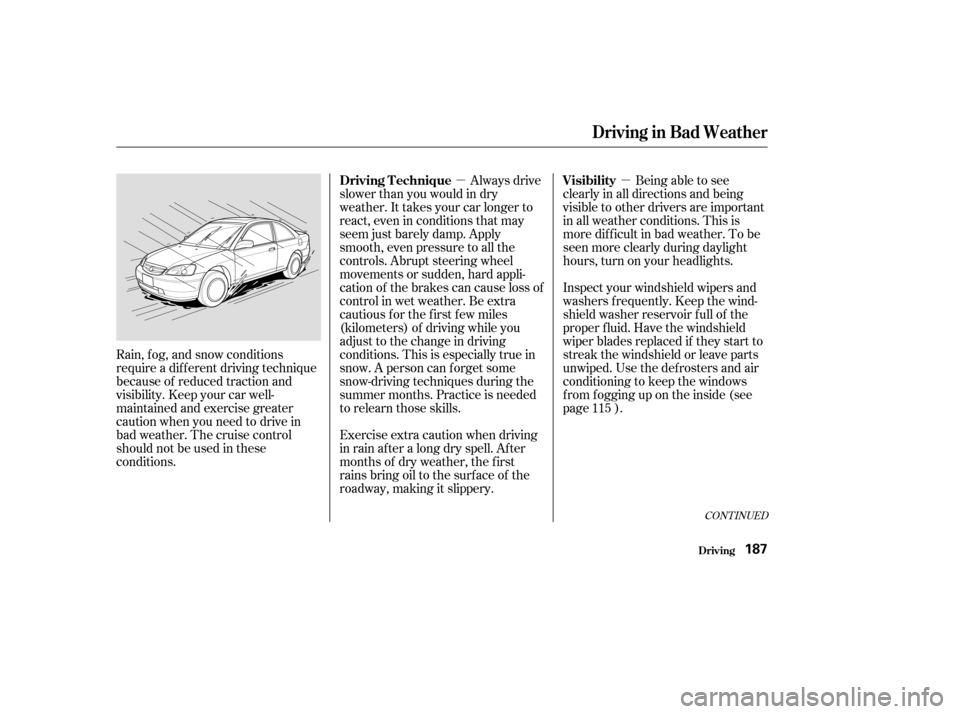Page 177 of 302

Check your brakes af ter driving
through deep water. Apply the
brakes moderately to see if they f eel
normal. If not, apply them gently and
f requently until they do. Since a
longer distance is needed to stop
with wet brakes, be extra cautious
and alert in your driving.
Constant application of the brakes
when going down a long hill builds
up heat and reduces their ef f ective-
ness. Use the engine to assist the
brakes by downshif ting to a lower
gear and taking your f oot of f the
accelerator pedal.
All Civics are equipped with f ront
disc brakes. The brakes on the rear
wheels are drum. A power assist
helps reduce the ef f ort needed on
the brake pedal.
Put your f oot on the brake pedal only
when you intend to brake. Resting
your f oot on the pedal keeps the
brakes applied lightly, causing them
to build up heat. Heat build-up can
reduce how well your brakes work. It
also keeps your brake lights on all
the time, conf using drivers behind
you. When the brake pads need replacing,
you will hear a distinctive metallic
‘‘screeching’’ sound when you apply
the brakes. If you do not have the
brake pads replaced, they will begin
screeching all the time.
Your brakes may sometimes squeal
or squeak when you apply them
lightly. Do not conf use this with the
brakewearindicators.Theymakea
very audible ‘‘screeching.’’
The f ront disc brakes on all models
have audible brake wear indicators.
Brake Wear Indicators
The Braking System
Driving183
�����—�����—�����y�
������
������y���
�(���%�������y���
�����y
Page 178 of 302

The hydraulic system that operates
the brakes has two separate circuits.
Each circuit works diagonally across
the vehicle (the lef t-f ront brake is
connected with the right-rear brake,
etc.). If one circuit should develop a
problem, you will still have braking
at two wheels.this defeats the
purpose of the ABS. Let the ABS
work f or you by always keeping f irm,
steady pressure on the brake pedal
as you steer away from the hazard.
This is sometimes ref erred to as
You will f eel a pulsation in the brake
pedal when the ABS activates, and
you may hear some noise. This is
normal; it is the ABS rapidly
pumping the brakes.
The U.S. EX model and Canadian
Si-G model have an Anti-lock Brake
System (ABS) as standard
equipment.
When the f ront tires skid, you lose
steering control; the car continues
straightaheadeventhoughyouturn
the steering wheel. The ABS helps to
prevent lock-up and helps you retain
steering control by pumping the
brakes rapidly; much f aster than a
person can do it.
ABS helps to prevent the wheels
f rom locking up and skidding during
hard braking, allowing you to retain
steering control.
‘‘stomp and steer.’’
Brake System Design A nti-lock Brakes You should never pump the
brake pedal;
The Braking System
Driving184
Front
�����—�����—�����y�
������
��
���y���
�(���%�������y���
�����y
Page 179 of 302

on loose or
uneven surf aces, such as gravel or
snow, than a vehicle without anti-
lock. Slow down and allow a greater
distance between vehicles under
those conditions.
it
only helps with steering control
during braking. You should always
maintain a saf e f ollowing distance
f rom other vehicles.
such as trying to take a
corner too f ast or making a sudden
lane change. Always drive at a safe,
prudent speed f or the road and
weather conditions.
Always steer moderately
when you are braking hard. Severe
or sharp steering wheel movement
can still cause your car to veer into
oncoming traffic or off the road.
Activation varies with the amount of
traction your tires have. On dry
pavement, you will need to press on
thebrakepedalveryhardbeforeyou
activate the ABS. However, you may
feel the ABS activate immediately if
you are trying to stop on snow or ice.
CONT INUED
A vehicle with A BS may require a
longer distance to stop
A BS does not reduce the time or
distance it takes to stop the car;
A BS will not prevent a skid that
results f rom changing direction
abruptly,
A BS cannot prevent a loss of
stability.Import ant Saf et y Reminders
The Braking System
Driving185
�����—�����—�����y�
������
������y���
�(���%�������y���
�����y
Page 180 of 302
The ABS is self -checking. If anything
goes wrong, the ABS indicator on
the instrument panel comes on (see
page ). This means the anti-lock
f unction of the braking system has
shut down. The brakes still work like
a conventional system without anti-
lock, providing normal stopping
ability. You should have the dealer
inspect your car as soon as possible.65
U.S. EX and Canadian Si-G
A BS Indicat or
The Braking System
Driving186
ABS INDICATOR
�����—�����—�����y�
������
������y���
�(���%�������y���
�����y
Page 181 of 302

�µ
�µ Being able to see
clearly in all directions and being
visible to other drivers are important
in all weather conditions. This is
more dif f icult in bad weather. To be
seen more clearly during daylight
hours, turn on your headlights.
Inspect your windshield wipers and
washers f requently. Keep the wind-
shield washer reservoir f ull of the
proper f luid. Have the windshield
wiper blades replaced if they start to
streak the windshield or leave parts
unwiped. Use the def rosters and air
conditioning to keep the windows
f rom f ogging up on the inside (see
page ).
Exercise extra caution when driving
in rain af ter a long dry spell. Af ter
months of dry weather, the f irst
rains bring oil to the surf ace of the
roadway, making it slippery.
Rain, f og, and snow conditions
require a dif f erent driving technique
because of reduced traction and
visibility. Keep your car well-
maintained and exercise greater
caution when you need to drive in
bad weather. The cruise control
should not be used in these
conditions. Always drive
slower than you would in dry
weather. It takes your car longer to
react, even in conditions that may
seem just barely damp. Apply
smooth, even pressure to all the
controls. Abrupt steering wheel
movements or sudden, hard appli-
cation of the brakes can cause loss of
control in wet weather. Be extra
cautious f or the f irst f ew miles
(kilometers) of driving while you
adjust to the change in driving
conditions. This is especially true in
snow. A person can f orget some
snow-driving techniques during the
summer months. Practice is needed
to relearn those skills. 115
CONT INUED
Visibility
Driving T echnique
Driving in Bad Weather
Driving187
�����—�����—�����y�
������
������y���
�(���%�������y���
�����y
Page 184 of 302

Be sure
there is adequate ventilation
whenever you operate the engine.
Let the
engine and exhaust system cool
bef ore touching any parts.
Do
not run the engine unless in-
structed to do so. Read the instructions before you
begin, and make sure you have the
tools and skills required.
Bef ore you begin any maintenance,
make sure your car is parked on
level ground and that the parking
brake is set. Also, be sure the engine
is of f . This will help to eliminate
several potential hazards:
You should wear eye protection and
protective clothing when working
near the battery or when using
compressed air.
To reduce the possibility of f ire or
explosion, be caref ul when working
around gasoline or batteries. Use a
commercially available degreaser or
parts cleaner, not gasoline, to clean
parts. Keep cigarettes, sparks, and
flames away from the battery and all
f uel-related parts.
Maintenance Saf ety
Maint enance
Important Saf ety Precautions
Carbon monoxide poisoning
f rom engine exhaust.
Burns f rom hot parts.
Injury f rom moving parts.
191
�����—�����—�����y�
���������
�
�y���
�(���%�������y���
�����y
Page 185 of 302

�µ
The Maintenance Schedule specif ies
how of ten you should have your car
serviced and what things need
attention. It is essential that you have
your car serviced as scheduled to
retain its high level of saf ety,
dependability, and emissions control
perf ormance.
Avoidexceedingyourcar’sload
limit.Thisputsexcessstresson
the engine, brakes, and many
other parts of your car. The load
limit is shown on the label on the
driver’s doorjamb.
Operate your car on reasonable
roads within the legal speed limit.
Drive your car regularly over a
distance of several miles
(kilometers).
Always use unleaded gasoline with
theproperoctanerating(seepage).
The services and time or distance
intervals shown in the maintenance
schedule assume you will use your
car as normal transportation f or
passengers and their possessions.
You should also f ollow these
recommendations:
Service your car according to the
time and mileage periods on one of
the Maintenance Schedules on the
f ollowing pages.
Follow the
Maintenance Schedule f or Severe
Conditions if you drive your car
MAINLY under one or more of the
f ollowing conditions.
Driving less than 5 miles (8 km)
per trip or, in f reezing
temperatures, driving less than 10
miles (16 km) per trip.
Driving in extremely hot [over
90°F (32°C)] conditions.
Extensive idling or long periods of
stop-and-go driving, such as a taxi
or a commercial delivery vehicle.
Driving with a roof rack, or driving
in mountainous conditions.
156
Maintenance Schedule
Maint enance
Which Schedule to Follow:
U.S. Owners
192
�����—�����—�����y�
�������������y���
�(���%�������y���
�����y
Page 187 of 302

�µ
�Ì
�Î �Î �Ì�Ì
�Î �Î
Maint enance194
miles x 1,000
km x 1,000
months
Service at the indicated distance or time whichever comes first. 10
16
Check oil and coolant at each fuel stop
2032
40645080 70
112 80
128 110176
Every 110,000 miles (176,000 km)
Inspect every 110,000 miles (176,000 km), otherwise adjust only if noisy Every 110,000 miles (176,000 km) or 7 years
At 120,000 miles (192,000 km) or 10 years,
then every 60,000 miles (96,000 km) or 5 years Every 3 years (independent of mileage)
Replace engine oil
Rotate tires (Check tire inflation and condition at least once per month)
Replace engine oil filter
Check engine oil and coolant
Inspect front and rear brakes
Check parking brake adjustment
Visually inspect the following items:
Tie rod ends, steering gear box and boots, Suspension components
Driveshaft boots, Brake hoses and lines (including ABS)
All fluid levels and condition of fluidsExhaust system, Fuel lines and connections
Inspect and adjust drive belts
Replace dust and pollen filter
Replace transmission fluid
Replace air cleaner element
Replace spark plugs
Inspect valve clearance
Replace timing belt, inspect auto-tensioner, and water pump
Inspect idle speed
Replace engine coolant
Replace brake fluid
Service the following items at the recommended intervals.Every 30,000 miles (48,000 km)
30 48
609690
144 100160 120192
See information on maintenance and emissions warranty, last column, page .
Replace at 120,000 miles (192,000 km) or 6 years, then every 90,000 miles (144,000 km) or 5 years.
See dust and pollen filter on page for replacement information under special driving conditions. 24 48 72
12 36 60
:
1:2: M/T
A/TCVT
193
229
1
2
Maintenance Schedule for Normal Conditions
�����—�����—�����y�
�����������
�y���
�(���%�������y���
�����y